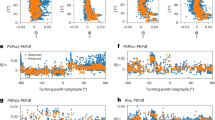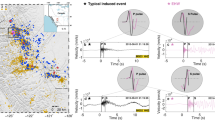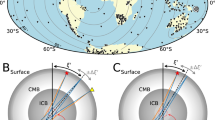Abstract
THE eigenfrequencies, nσl of the torsional modes, nTl, of a spherically symmetrical, nonrotating, elastic, isotropic Earth model, are defined, for fixed wave number k=(l+ 1/ 2 )/a, by the eigenvalue problem  (where U=U(r); μ = μ(r); ρ = ρ(r); a ≤ r ≤ b) and by the (zero stress) boundary conditions
(where U=U(r); μ = μ(r); ρ = ρ(r); a ≤ r ≤ b) and by the (zero stress) boundary conditions  where μ, denotes rigidity, ρ density, a the radius of the core and b the radius of the Earth1.
where μ, denotes rigidity, ρ density, a the radius of the core and b the radius of the Earth1.
This is a preview of subscription content, access via your institution
Access options
Subscribe to this journal
Receive 51 print issues and online access
$199.00 per year
only $3.90 per issue
Buy this article
- Purchase on SpringerLink
- Instant access to full article PDF
Prices may be subject to local taxes which are calculated during checkout
Similar content being viewed by others
References
Alterman, Z., Jarosch, H., and Pekeris, C. L., Proc. R. Soc., A 252, 80 (1959).
Haddon, R. A. W., and Bullen, K. E., Phys. Earth planet. Interiors, 2, 35 (1969).
Brune, J. N., and Gilbert, F., Bull. seism. Soc. Am., 64, 313 (1974).
Brune, J. N., Bull. seism. Soc. Am., 54, 2099 (1964).
Author information
Authors and Affiliations
Rights and permissions
About this article
Cite this article
ANDERSSEN, R., OSBORNE, M. & CLEARY, J. Asymptotic structure in torsional free oscillation data for the Earth. Nature 250, 400–401 (1974). https://doi.org/10.1038/250400a0
Received:
Issue date:
DOI: https://doi.org/10.1038/250400a0



